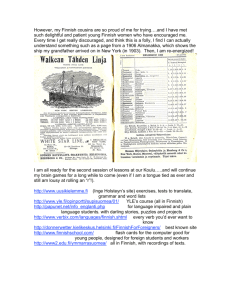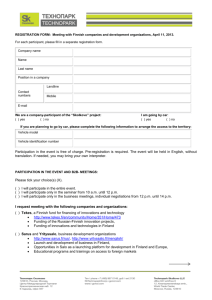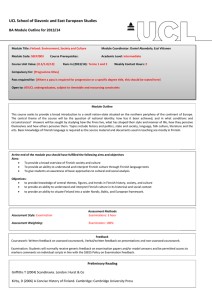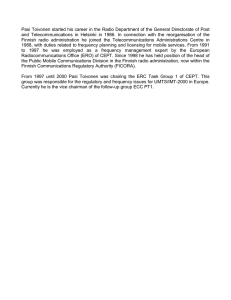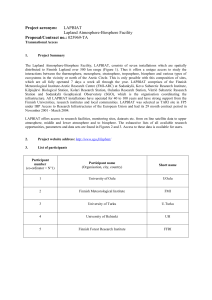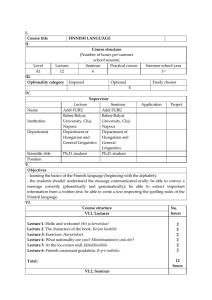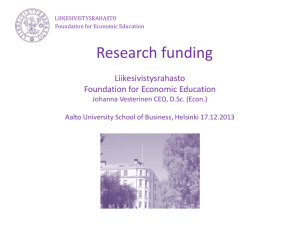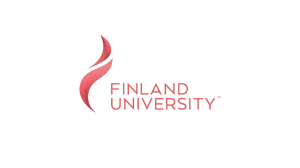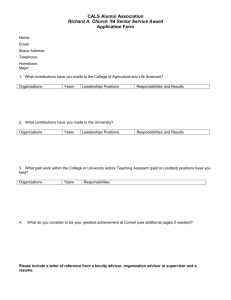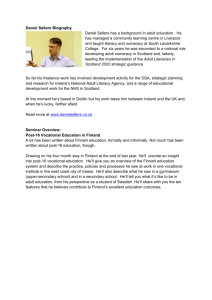- Society for Research into Higher Education
advertisement
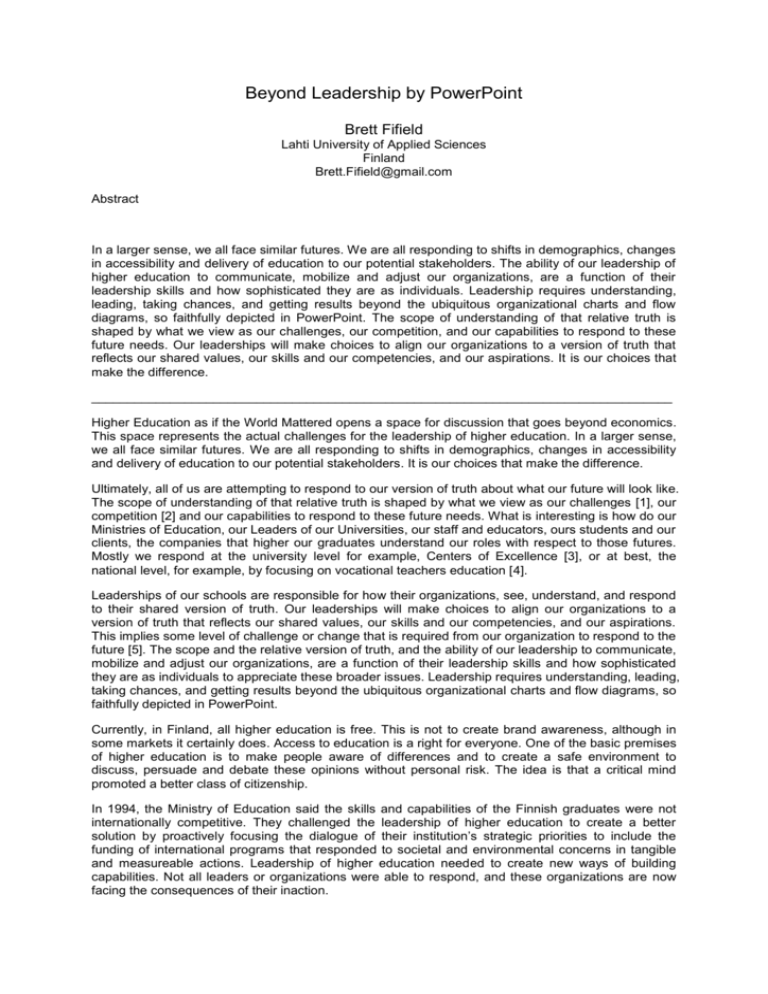
Beyond Leadership by PowerPoint Brett Fifield Lahti University of Applied Sciences Finland Brett.Fifield@gmail.com Abstract In a larger sense, we all face similar futures. We are all responding to shifts in demographics, changes in accessibility and delivery of education to our potential stakeholders. The ability of our leadership of higher education to communicate, mobilize and adjust our organizations, are a function of their leadership skills and how sophisticated they are as individuals. Leadership requires understanding, leading, taking chances, and getting results beyond the ubiquitous organizational charts and flow diagrams, so faithfully depicted in PowerPoint. The scope of understanding of that relative truth is shaped by what we view as our challenges, our competition, and our capabilities to respond to these future needs. Our leaderships will make choices to align our organizations to a version of truth that reflects our shared values, our skills and our competencies, and our aspirations. It is our choices that make the difference. _________________________________________________________________________________ Higher Education as if the World Mattered opens a space for discussion that goes beyond economics. This space represents the actual challenges for the leadership of higher education. In a larger sense, we all face similar futures. We are all responding to shifts in demographics, changes in accessibility and delivery of education to our potential stakeholders. It is our choices that make the difference. Ultimately, all of us are attempting to respond to our version of truth about what our future will look like. The scope of understanding of that relative truth is shaped by what we view as our challenges [1], our competition [2] and our capabilities to respond to these future needs. What is interesting is how do our Ministries of Education, our Leaders of our Universities, our staff and educators, ours students and our clients, the companies that higher our graduates understand our roles with respect to those futures. Mostly we respond at the university level for example, Centers of Excellence [3], or at best, the national level, for example, by focusing on vocational teachers education [4]. Leaderships of our schools are responsible for how their organizations, see, understand, and respond to their shared version of truth. Our leaderships will make choices to align our organizations to a version of truth that reflects our shared values, our skills and our competencies, and our aspirations. This implies some level of challenge or change that is required from our organization to respond to the future [5]. The scope and the relative version of truth, and the ability of our leadership to communicate, mobilize and adjust our organizations, are a function of their leadership skills and how sophisticated they are as individuals to appreciate these broader issues. Leadership requires understanding, leading, taking chances, and getting results beyond the ubiquitous organizational charts and flow diagrams, so faithfully depicted in PowerPoint. Currently, in Finland, all higher education is free. This is not to create brand awareness, although in some markets it certainly does. Access to education is a right for everyone. One of the basic premises of higher education is to make people aware of differences and to create a safe environment to discuss, persuade and debate these opinions without personal risk. The idea is that a critical mind promoted a better class of citizenship. In 1994, the Ministry of Education said the skills and capabilities of the Finnish graduates were not internationally competitive. They challenged the leadership of higher education to create a better solution by proactively focusing the dialogue of their institution’s strategic priorities to include the funding of international programs that responded to societal and environmental concerns in tangible and measureable actions. Leadership of higher education needed to create new ways of building capabilities. Not all leaders or organizations were able to respond, and these organizations are now facing the consequences of their inaction. Our approach to higher education builds on these broader themes, but pushes our delivery processes of creating sustainable educational platforms as a project network [6]. We approached Masters Level education as collaborative, strategically focused but pragmatically messy space, which creates commercially viable new business opportunities in the emerging markets, for the environmental sector. We wanted to go beyond the traditional secondary research of Masters Education [7]. We built a platform that recruited students from the emerging markets, brought them to Finland for free, allowed them to manage a large group of between 50 and 70 undergraduates, including exchange students, for an entire fall semester. This project creates a substantial package of coordinated secondary data / material that is analyzed with respect to business opportunities in three or four environmental markets, in three countries. This material is shared between and is available for the entire class at both undergraduate and graduate levels for their thesis projects. As an interesting twist, the graduate students also had to compete with their undergraduate “employees” in order to show value added roles as master’s students. Additionally, they were also required to bring the entire project in on budget. After the presentations of the strategic market opportunities, the students were required to evaluate each other’s performance, both as a team and as individuals from both the graduate and the undergraduate students. In the spring term, the group was then divided into clusters based on their selection their master thesis topic, and these clusters provided sparing members while developing their field research plans. The students presented their proposal and based on achievability, they were each provided 1000 euros of support for going to the target market to conduct an intensive field research and clarify their initial analysis of the market opportunities. Each student completed a PESTEL [8], Porters Five Forces [9], created a stakeholder analysis [10] and provided a specific strategic approach for developing a specific market opportunity. Prior to graduation, the students have now contacted several of the potential companies and players with respect to the market opportunity. This approach to building a project network allowed a student to gain the market credibility when approaching potential employers. These were no longer students with limited industry experience. These were professional colleagues that understood the market issues and opportunities to contribute a strategic value added role for an organization. These graduates represent the sustainable bridges between economic and commercial markets, new green technologies, and cultural philosophies. In 18 months, we consistently graduated over ninety percent of the students on time, with real industry knowledge, and real business development capabilities. Our quality assessment program was able to track changes in the individual’s self-perception of their individual capabilities and industry specific capacities over the four phases of the program, thereby documenting the industry capabilities targets set by the Finnish Ministry of Education [11]. [1], Bakia, Marianne, Shear, Linda, Toyama, Yukie and Lasseter, Austin, (2012) Understanding the Implications of Online Learning for Educational Productivity, US Department of Education, Office of Educational Technology [2] www.edx.org [3] Hiltunen, Kirsi, (2009) Centers of Excellence in Finnish University Education, 2010 – 2012, Publications of the Finnish Higher Education Evaluation Council, 3:2009, ISBN 978-952-206-102-7 [4] Moon, Bob, Vlasceanu, Lazar, and Barrows, Leland Conley, (2003) Studies on Higher Education, Institutional Approaches to Teacher Education within Higher Education in Europe: Current Models and New Developments, Unesco 2003, ISBN 92-9069-173-X [5] Johnson, Spencer (1998) Who Moved My Cheese?, G.P. Putnam’s Sons, New York [6] Fifield, Brett (2008) A Project Network: an Approach to Creating Emergent Business, The Helsinki School of Economics, Doctoral Thesis, ISBN 978-952-488-206-4 [7] Maassen, Peter, Kallioinen, Outi, et. al. (2012) From the Bottom Up, Evaluation of RDI Activities of Finnish Universities of Applied Sciences, Publications of the Finnish Higher Educations Evaluations Council, 7:2012 [8] Kotler, P. (1998) Marketing Management – Analysis, Planning, Implementation, and Control, 9th Edition, Englewood Cliffs: Prentice-Hall [9] Porter, M. (1980) Competitive Strategy, New York: The Free Press. [10] Mitchell, Ronald K., Agle, Bradley R., and Wood, Donna J., (1997) A Theory of Stakeholder on Salience: Defining the Who and What Really Counts, The Academy of Management Review, Volume 22, No. 4, Oct., 1997, pp. 853 – 886. [11] Torniainen, Ilona, Mahlamäki-Kultanen, Seija, Nokelainen, Petri and Ilsley, Paul (2011) Innovations for Competence Management Conference Proceedings, Series C Articles, part 83. Submission 1 March Part 1 Abstract 150 words summary Part 2 Outline 1000 word paper, no requirement for fuller paper
